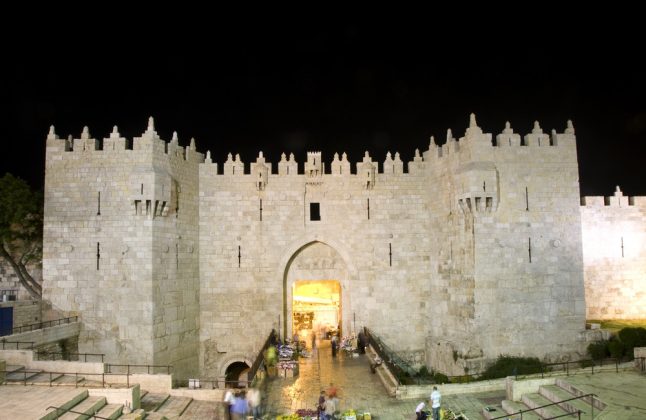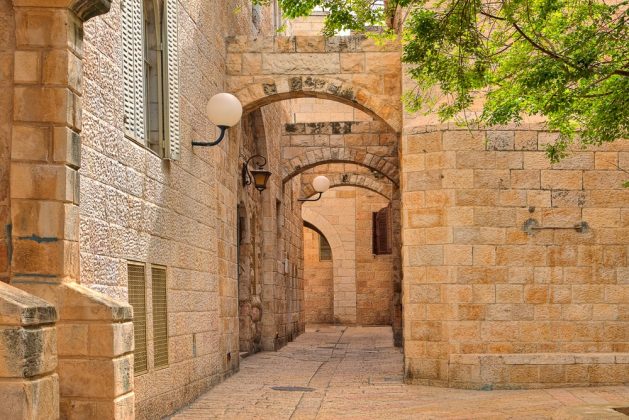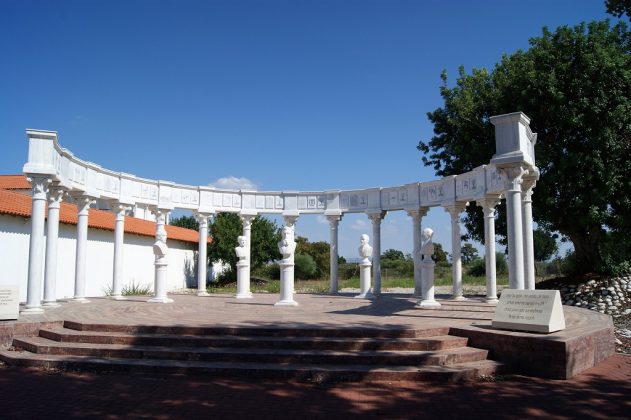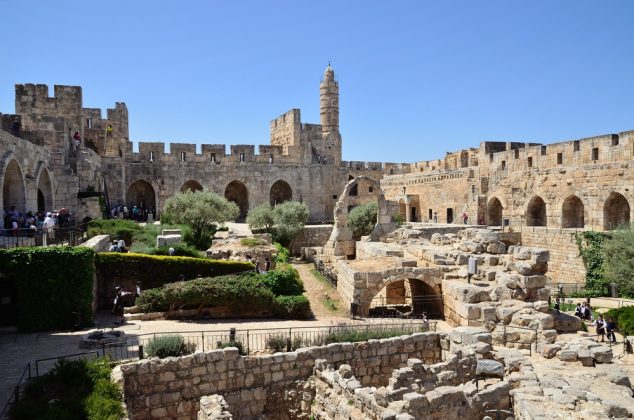History of the archaeology of Israel
The archaeology of Israel is a very complex and large topic due to the ancient history of Israel. The ancient Land of Israel was a connection between Mesopotamia and Egypt culture. The history of the Land of Israel can be divided in different periods.
The Neolitic period, dated 8500-4300 BCE, started when Natufian ( term coined by Dorothy Garrod in the 1928 ) culture people migrated to Syria, Israel and Lebanon practicing the agriculture, this represents the Neolithic Revolution and it is related to the Younger Dryas that is the cold period. Natufian sites in Israel are Ain Mallaha, el-Wad, Ein Gev, Hayonim cave, Nahal Oren and Kfar HaHoresh.
The Bronze Age or Canaanite period, dated 3300-1200 BCE, characterized by the use of the bronze and together with the Iron Age, they are known as the Biblical period. The Late Bronze Age is featured by the building of individual city-states, that were subjected to invasions and dominations such as Egypt. The Iron Age or Israelite period was around 1200 BCE when the main tool was the iron and the birth of urban dwellings and new local cultures.
The Roman period starts from 63 BCE until the 330 CE, divided in Early Roman period, Middle Roman period and Late Roman period. In particular the end of the middle Roman period coincides with the end of the Jewish culture of Judea and the beginning of the Rabbinic Judaism with Rabbi Yochanan Ben Zakai in the city of Yavne, this is why the late Roman period is called Yavne Period. Important archaeological sites of this period are in Masada, Herodium and Caesarea Maritima.
The Byzantine period, dated 330-638 CE, spreading from the advent of the Christianity in Rome until the Muslim conquest of the Land of Israel.
The first ten archaeological sites to visit
The first ten notable archeological sites to visit in Israel are Jerusalem, Ashkelon, Beit Alfa, Carmel Caves, Mamshit, Old Acre, Tel Rehov, Tel Beersheba, Tel Megiddo, Beit Shearim, Gath, Gezer, Masada, Tel Arad, Tel Dan, Tel Hazon, Tzippori, Gesher Bnot Yaakov and Ain Mallaha.
Old Jerusalem
It’s really impossible to describe the old city of Jerusalem in few words. To say that the old Jerusalem is one of the most unique places in the world, it is not enough and not only because of the amount of its inner archaeological sites but also for the spiritual sense that this intense place has for the Jewish, Islamic and Christian religions.
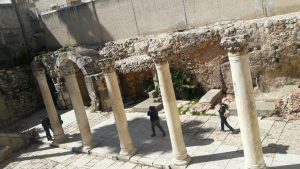
Ashkelon
Ashkelon cointains 15 m of accumulated rubble from Canaanite, Philistine, Phoenician, Persian, Hellenistic, Roman, Byzantine, Islamic, and Crusader occupation. Graves of pre-Phoenician Canaanites, a Bronze Age vault and a silvered bronze statue of a bull calf deserve to be cited.
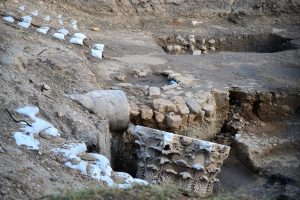
Beit Alfa
Beit Alfa is the site of an ancient Byzantine-era synagogue, constructed in the 5th century CE, with a three-paneled mosaic floor, that is one of the most important discoveries in Israel, is structured in three panels, each one representing the Holy Ark, the zodiac and the Akeidah-the sacrifice of Isaac. In the center there is Helios, the sun god, and at the four corners four women representing the four seasons.
The Carmel Caves
The Carmel Caves , that is the Misliya Cave, is in the southern region of Mt. Carmel, where hand-held stone tools, blades and animal bones, dated at the time of the Mousterian culture of Neanderthals in Europe, have been discovered.
Mamshit
Mamshit is the Nabatean city of Memphis ( Kurnub in Arabic ), where the largest hoard of coins of Israel has been found with 10,500 silver coins in a bronze jar, dated 3rd century CE. Mamshit is the smallest city found in the Negev besides Avdat, Haluza and Shivta.
Old Acre(Akko)
Acre’s Old City has been an archaeological site always full of discoveries such as the underground passageway leading to a 13th-century fortress of the Knights Templar, dating 1104-1291 CE.
Tel Rehov, besides to be known as an important Bronze and Iron Age archaeological site, it represents one of the largest ancient city mounds in Israel covering a total area of 120,000 m2, it is divided in Upper City and Lower City. In the 2007, 30 intact beehives dated 10th – 9th century BCE, have been found, indicating that the apiculture industry started 3000 years ago.

Tel Beersheba
Tel Beersheba is an archaeological site in southern Israel, believed to be the remains of the biblical town of Beersheba, dated 4000 BCE at the time of the Chalcolithic period, with a relevant presence of underground water as indicated by the presence of many wells.
Tel Megiddo
Tel Megiddo is a vast region of twenty-six stratified layers of the ruins of ancient cities close to the Carmel Bridge, in this archeological site twenty levels of habitation have been discovered, some remains are kept in the Rockefeller Museum of Jerusalem and the Oriental Institute of the University of Chicago.
Beit Shearim
Beit Shearim was a Jewish town and necropolis, near the town of Kyriat Tiv’on, 20 km east of Haifa in the Lower Galilee. The remains, dated 2nd -4nd century CE, include more than twenty catacombs of the necropolis, with images and inscriptions on walls and sarcophagi that show that Beit Shearim was a Jewish necropolis.
Gath
Gath or Tell es-Safi is one of the largest pre-Classical sites in Israel, between Jerusalem and Ashkelon, and it was an important site in the Bronze and Iron Ages, and in the Crusader period. It contains an impressive late 9th-century BCE destruction level (Stratum A3), evidence of the destruction of Gath by Hazael of Aram, the earliest known siege system in the world that surrounds the site.
Tel Gezer
Tel Gezer is an archaeological site on the western flank of the Shephelah, between Via Maris and Jerusalem, with a total area of 120,000 m2 and it is cited in many ancient sources like the Torah and the Amarna letters. Among the remains, it deserves particular attention the Gezer calendar, that was an agricultural calendar written in paleo-Hebrew script and one of the oldest known examples of Hebrew writing, dating to the 10th century BCE, six-chambered gate and ten monumental megaliths.
Masada
Masada is situated in the Southern District of Israel on top of a large mesa ( rock plateau ), and because of the desert climate it remained untouched during two millennia, even though most of the ancient buildings have been restored, among them a synagogue, where an ostracon with the inscription “tithe for the priest” has been found as fragments of two scrolls besides 28 skeletons.

Tel Arad
Tel Arad is situated in the west part of the Dead Sea, distant 10 km from the city of Arad, has a garrison town “The Citadel” built at the time of King David and King Solomon and a Judean temple.
Tel Dan
Tel Dan or Tell el-Qadi is a mound located at the northern Israel, dated at the Neolithic era around 4500 BCE, contains the Tel Dan Stele, a black basalt stele, erected by an Aramaean king.
Tel Hazor
Tel Hazor was hosting an ancient Canaanite city, which has been destroyed around the 13th century BCE. In the site have been founded six chambered gate built at the time of the Early Iron Age with other buildings and pottery dating 10th century.
Tzippori
Tzippori is an archaeological site located in the Central Galilee, at 6 km north from Nazareth, and that is full of historical artifacts coming from different cultures like the Assyrian, Hellenistic, Judean, Babylonian, Roman, Byzantine, Islamic, Crusader, Arabic and Ottoman. The relevant remains, besides a large amount of mosaics, is a 6th-century synagogue, a Roman villa which dates 200 CE, a Roman theater and the remains of a 5th-century public building.
Gesher Bnot Ya’akov
Gesher Bnot Ya’akov is a 780,000-year-old archaeological site on the banks of the Jordan river in northern Israel, and one of the rarest prehistoric sites in the world, it has an unique level of organic preservation better than other archaeological sites in Europe and Asia.
Ain Mallaha
Ain Mallaha, which is a Natuflian village, colonized between the 12,000 BCE and the 9600 BCE, hosts the earliest evidence of dog’s domestication like the burial of a man with a dog.



